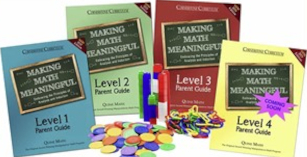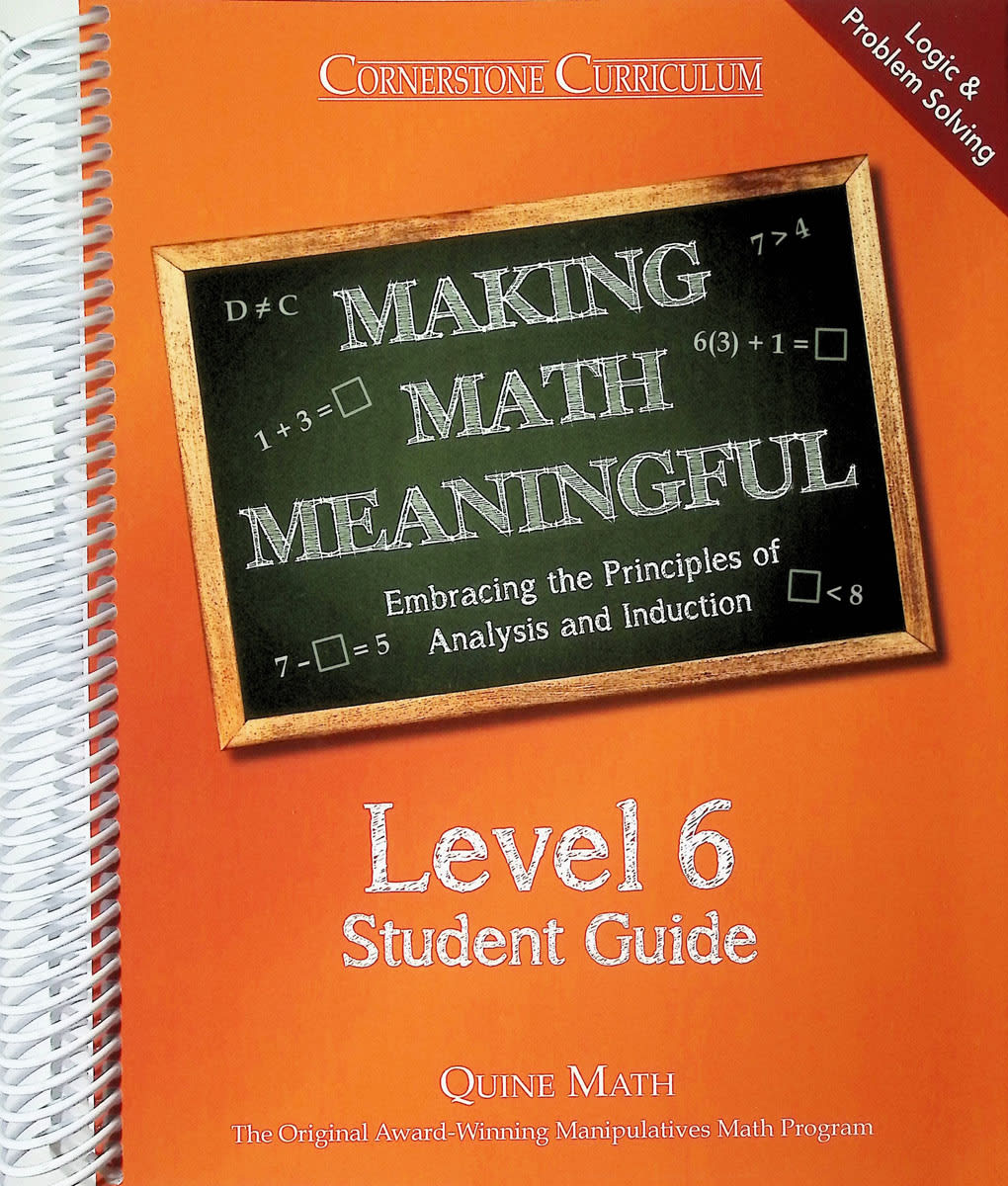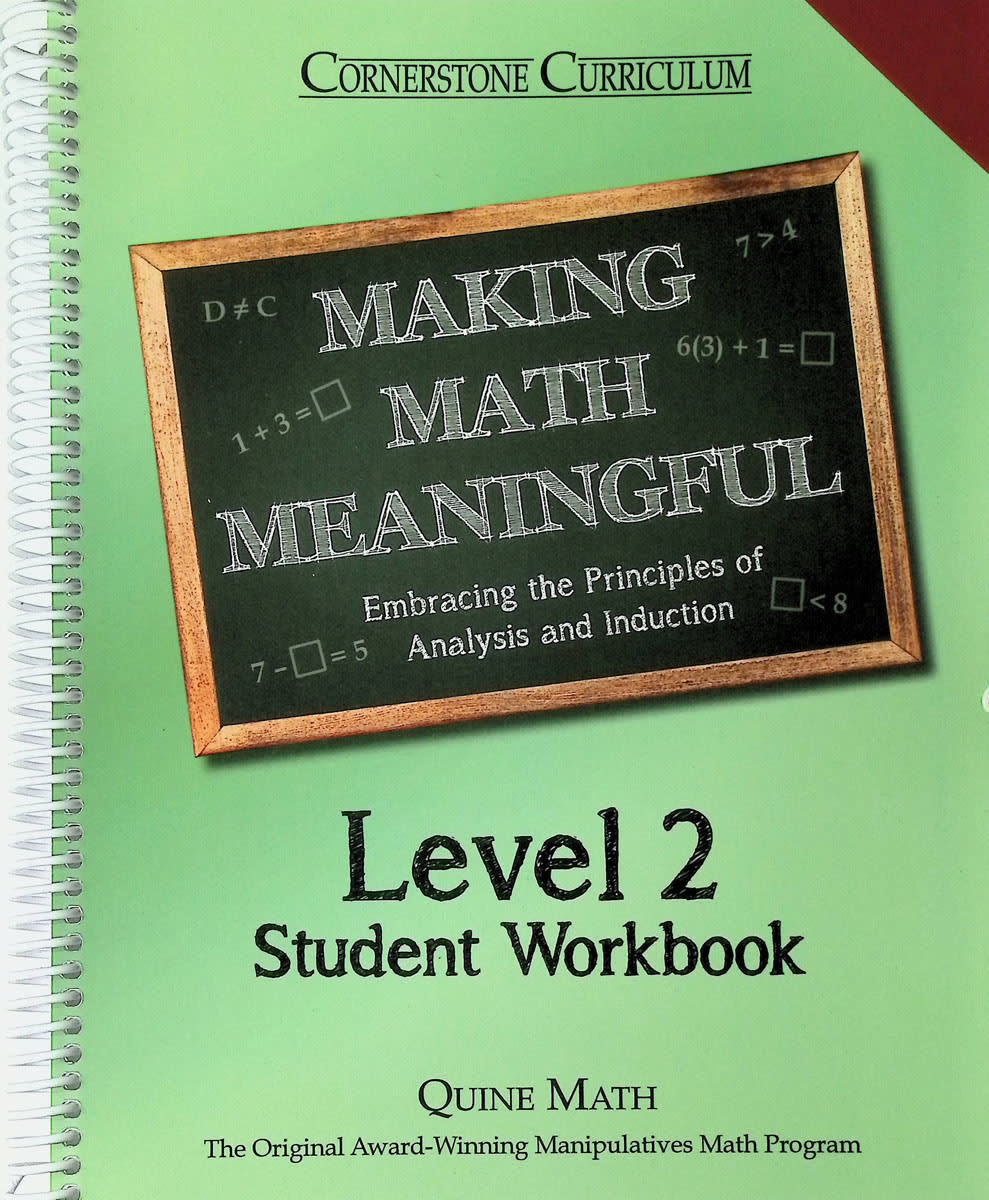Making Math Meaningful uses unique methods of presentation based upon sound research and a biblical Christian worldview. Concepts are taught using a three-step approach: observation, interpretation, and application. In the observation stage, manipulatives and conversation are used to introduce a concept. Children are often given the opportunity to discover mathematical concepts through their observations and work with manipulatives rather than through direct instruction. In the interpretation stage, the concept is explained to the student using mathematical terminology. In the application stage, children are given opportunities to apply what they have learned.
Level K through Level 4 each require a parent guide and student book. These levels also require you to have a separate notebook (such as an inexpensive spiral notebook) and the Math Manipulatives Kit that has links, large chips, and Unifix® cubes. This same kit is used for grades K through 4 for presenting and practicing math concepts.
Level K through Level 3 are available in revised 2021 editions, with Level 4 still to come. For the revised editions, the parent guide is a perfect-bound, softcover book, and the student workbook has a spiral binding that allows the book to lay flat.
Detailed, scripted instruction is given for the parent in the parent guides for Level K through Level 4. The parent guides direct parents in what to say and do, so the courses must be presented one-on-one for those levels. The student books for the higher grade levels are written directly to students, so they can work independently. There are no parent guides for Level 5 and Level 6.
For kindergarten through fourth grade, students complete pages in their student workbook in conjunction with lesson presentations. Student workbooks cannot be used without the lesson presentations from the parent guides. Student books are consumable, and extra student books can be purchased for additional students. Parents need to make sure they have the hands-on resources required for each lesson, but otherwise, the lessons can be used in an open-and-go fashion.
Making Math Meaningful: Level 5, Making Math Meaningful: Level 6, and Principles from Patterns (algebra) are each presented in one, large book that contains both instructional material and exercise pages. Instructional material is addressed directly to the student. The courses for fifth grade and sixth grade are easy for students to work through on their own. Books for additional students are priced at half the cost. (Note: I review the algebra textbook, Principles from Patterns, separately.)
Making Math Meaningful seems to move more slowly than other math programs in the primary grades because the goal is a thorough understanding of concepts. However, the net result is that students are ready for the algebra level by seventh or eighth grade if they work through this entire program.
A few concepts (e.g., telling time and reading a calendar) taught in most programs are not covered here, but these are easily taught on their own. You can supplement with another resource if children need additional practice on computation skills.
Following are details about the individual levels.
Level K
Making Math Meaningful: Level K covers concepts such as equal and unequal, making equal lengths, putting things in order according to length or number, simple addition and subtraction with objects and representations, and writing the numerals to 20. Children will use the manipulatives kit and cut-outs from a few pages in the student workbook. Some lessons also use dry beans, string, crayons, and other items for hands-on learning.
As is appropriate for young learners, student worksheets are seldom used, while manipulatives are used frequently. The student workbook is not at all like other kindergarten math workbooks. Students often color in graphs to record their observations or to represent simple math concepts. They sometimes cut out pictures from the workbook and arrange them into groups. And they learn to write numbers about midway through the course.
The course has 34 lessons. Some of the lessons can be completed in one day, but others will be repeated or spread out over a number of days. Some kindergartners will complete the course well before the end of the school year. If so, and they are eager to learn more, you can go ahead and start working in Making Math Meaningful: Level 1.
Level 1
Making Math Meaningful: Level 1 appears simpler than other math courses at first glance because it does not have lots of pages full of problems to solve. It concentrates on fundamental math concepts for addition and subtraction rather than trying to also teach geometry, money, the calendar, telling time, and the many other concepts typically covered in first grade.
The student book has 152 pages, and a significant amount of the work on these pages requires drawing, recording and representing manipulative activities, and other work that develops conceptual understanding. Students complete some pages with abstract work, such as addition and subtraction problems, as the final step in the progression from hands-on work, to representations, and finally to the use of numerals and symbols.
Level 2
Making Math Meaningful: Level 2 continues to stress mathematical thinking and the understanding of concepts. By the end of Level 2, children will have advanced their understanding of addition and subtraction up through borrowing and carrying using numbers through 99. They learn about place value and are introduced to multiplication and division with objects. They also learn about fractions, the values of coins, how to compare liquid measurements, and algebraic equations. Word problems and applications are used throughout the course.
Level 3
In Level 3, students continue to learn about place value, addition, and subtraction—all of these up to 999. They also learn both multiplication and division—both basic facts and various ways to solve problems. For instance, page 134 in the student workbook has students fill in a box with >, <, or = for problems such as:
4 (14) + 2 □ 7 (15) + 2.
You can see how this type of problem calls for more sophisticated mathematical thinking and also prepares students for algebra they will encounter later on. Activities in the student workbook are often unusual, and they include puzzles and word problems.
Level 4
Level 4 presents more-challenging addition and subtraction (up to 999,999), the multiplication of two- and three-digit numbers, division (not including long division), and finding common denominators for fractions. (The image and price in the Pricing Information section below are for the second edition. I will update them when the new edition is available.)
Level 5
Making Math Meaningful: Level 5 is a single 336-page book. Unlike the lower-level student workbooks, Level 5 is designed for the student to work independently. The answer key is at the back of the book so, if necessary, remove it.
The unique methods of presentation that stress conceptual understanding become increasingly important. For example, when students learn complex multiplication and division, they are shown why it works rather than just the steps they need to memorize. Students are occasionally directed to collect materials for hands-on activities: pennies, LEGO® blocks or similar math manipulatives, and toothpicks. Such instances are not very frequent, and the materials should not be difficult to obtain.
The scope and sequence is a little unusual. For example, long division is taught up through single-digit divisors and division by multiples of 10, while most fifth-grade courses have moved beyond to multi-digit divisors. However, fraction concepts are presented in algebraic forms advanced beyond most courses at this level.
Students work more on concepts, patterns, logic, and word problems than on computation skills. The book is consumable, and you will need a separate book for each student taking the course.
Level 6
See the description of Level 5. The format is the same for Level 6, but to complete the foundation in basic arithmetic, the concepts covered include fractions, decimals, percents, and division. By the time children complete this level, they are prepared for the study of algebra, although they might not be mature enough to comprehend algebra lessons as presented in most first-year algebra courses. However, students who have completed Level 6 should be ready for the Making Math Meaningful algebra textbook, Principles from Patterns, since they already have a foundation of conceptual understanding as a consequence of their studies within the Making Math Meaningful curriculum. Moving ahead into algebra is possible at this point because Principles from Patterns continues to use a more concrete presentation than do other algebra courses.
Summary
Making Math Meaningful is a very affordable math program. Even the manipulatives are relatively inexpensive. The program up through fourth grade is easy for parents to teach, and the scripting provides a high level of confidence for inexperienced parents who want to teach using a hands-on approach. The methodology is well thought out and consistently applied throughout the program.













